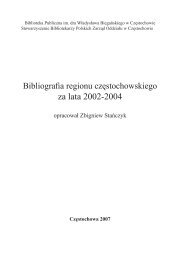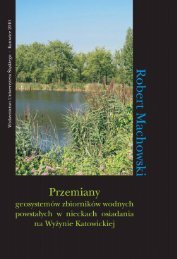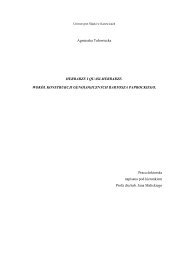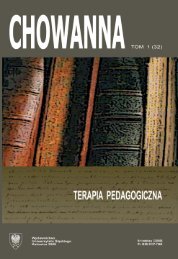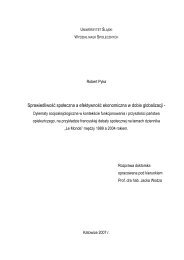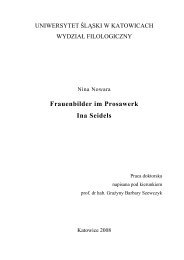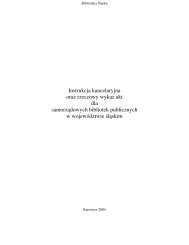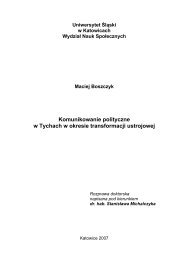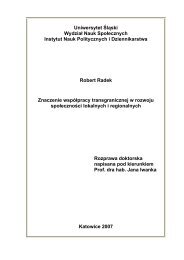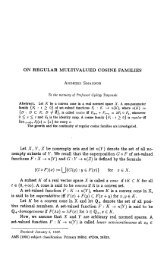Surface Microstructure of Chitosan Membranes – AFM Investigations
Surface Microstructure of Chitosan Membranes – AFM Investigations
Surface Microstructure of Chitosan Membranes – AFM Investigations
You also want an ePaper? Increase the reach of your titles
YUMPU automatically turns print PDFs into web optimized ePapers that Google loves.
Polish J. <strong>of</strong> Environ. Stud. Vol. 15 No. 4A (2006), 84-87<strong>Surface</strong> <strong>Microstructure</strong> <strong>of</strong> <strong>Chitosan</strong><strong>Membranes</strong> <strong>–</strong> <strong>AFM</strong> <strong>Investigations</strong>Z. Modrzejewska 1 , J. Stawczyk 1 , K. Matyka 2 , M. Matyka 3 ,I. Mróz 2 , A. Ciszewski 21 Faculty <strong>of</strong> Process and Environmental Engineering, Technical University <strong>of</strong> ód,ul. Wólczaska 213/215, 93-005 ód, Poland2 Institute <strong>of</strong> Experimental Physics, University <strong>of</strong> Wrocaw, Plac Maxa Borna 9, 50-204 Wrocaw, Poland3 Institute <strong>of</strong> Theoretical Physics, University <strong>of</strong> Wrocaw, Plac Maxa Borna 9, 50-204 Wrocaw, PolandAbstractWe present the <strong>AFM</strong> investigations <strong>of</strong> chitosan membranes’ surfaces. We observe the surfacemicrostructures and compare the surface areas <strong>of</strong> chitosan formate and two forms (white and transparent) <strong>of</strong>chitosan acetate. The results suggest that the surface <strong>of</strong> chitosan formate is better developed than the surface <strong>of</strong>white chitosan aceteate. The transparent chitosan acetate forms the most heterogenous surface.Keywords: chitosan membranes, surface microstructure, <strong>AFM</strong>Introduction<strong>Chitosan</strong> (Fig.1a) is a natural polymer revealingunique characteristics that predispose it especially tomedical applications. <strong>Chitosan</strong> is biocompatible andbiodegradable. It shows athrombogenic and haemostaticproperties. One <strong>of</strong> chitosan’s most promising features isits excellent ability to form porous structures [1] that areuseful in cell transplantation and tissue regeneration [2].Many possible medical applications <strong>of</strong> chitosan-derivedmaterials base on adsorption processes that can occur onthe materials’ surfaces. Therefore, the surfaces<strong>of</strong> chitosan-based membranes, films and multilayers arewidely discussed (e.g. [3-7]). Their microstructures,including roughness etc. can be effectively investigatedusing atomic force microscopy (<strong>AFM</strong>) and relatedtechniques (e.g. lateral force microscopy LFM [7]).In this paper we use the <strong>AFM</strong> method to investigatethe surface microstructure <strong>of</strong> chitosan acetate andchitosan formate membranes. We compare the surfaceareas <strong>of</strong> the membranes and test usefulness <strong>of</strong> <strong>AFM</strong> toinvestigate highly porous materials.Experimental proceduresHydrogel chitosan membranes were produced by thewet phase inversion method. <strong>Chitosan</strong>, low-viscous,<strong>of</strong> molecular weight 550 kDa and DD=75% (Fluka, 50494)was solved in acetic acid and formic acid to obtain chitosanacetate and chitosan formate as film forming solutions. Theamount <strong>of</strong> acetic acid was 0,42 g/g chitosan and the amount<strong>of</strong> formic acid was 0,3 g/g chitosan . Polymer concentration inthe solution was 5% and 7%. The solution was carried outwith a mixer (shaker, amplitude <strong>of</strong> oscillations: 8 mm),at temperature 20 o C. After aeration, the solution was pouredonto a flat surface (glass plate) using an applicator witha relevant gap (0.9 mm) that resulted in thin filmsformation. The chitosan membranes were formed byimmersing the thin films, immediately after pouringthe solution onto a flat surface (before the solvent hadevaoporated), into a coagulation bath. The coagulationprocess was carried out in a 10 % aqueous solution<strong>of</strong> sodium hydroxide, for 15 minutes. Then the membraneswere washed with water and conditioned in demineralizedwater to obtain pH = 7.0. To preserve their porous structure,
<strong>Surface</strong> <strong>Microstructure</strong> <strong>of</strong> <strong>Chitosan</strong>… 85oCH 2OHoOHoCH 2OHoOHooCH 2OHoOHoCH 2OHoOHoa)CH 3-CO-NHchitinCH 3-CO-NHnNH 2chitosanNH 2nb)1.4µmHeight /nmHeight /nm1.4µmLateral position/nm200nm200nmc)Lateral position/nmd)Fig. 1. (a) <strong>Chitosan</strong> [(14)-2 amino-2-deoxy--D-glucane] is a product <strong>of</strong> chitin [(14)-2 acetamido-2-deoxy--D-glucane]deacetylation. (b) <strong>Surface</strong> structure <strong>of</strong> white chitosan acetate, a = 7 m. The standard Height (left) and Deflection (center)images. The pr<strong>of</strong>ile (right) is taken along the marked line (c) Higher magnification (a =1 m) image shows better bulbousstructures (left<strong>–</strong>Height, center<strong>–</strong>Deflection). (d) An example <strong>of</strong> the dependence between scan size parameter a and Theorigin <strong>of</strong> the observed effects is discussed in the text. For the same scan sizes, smaller values <strong>of</strong> correspond to bigger totalsurface areas
86 Modrzejewska Z., et al.the membranes in the form <strong>of</strong> hydrogel were dried byconvection at low temperatures, in a closed air cycle.Drying <strong>of</strong> the membranes was carried out at temperatures <strong>–</strong>4 o C and <strong>–</strong>12 o C, air circulation was 0.6 ms -1 . For chitosanacetate we observed two forms <strong>of</strong> the membranes:transparent (created when the thickness <strong>of</strong> the hydrogelbefore drying was about 0.5 mm) and white (thicknessabout 0.9 mm). The surfaces <strong>of</strong> the dry membranes wereimaged using the Nanoscope IIIa, Veeco, working in thecontact mode and equipped with an oxide-sharpenedsilicon-nitride probe (NP-S). The length and the springconstant <strong>of</strong> the applied V-shaped cantilever were 196 mand 0.06 Nm -1 , resp. The measurements were performed inair, at room temperature. The lateral and vertical resolutionswere 10 nm and 1 nm. The <strong>AFM</strong> images were processedwith the s<strong>of</strong>tware package WSxM, Nanotec Electronica,Spain [8]. To calculate the total area <strong>of</strong> an imaged surfacewe approximated the surface by a triangular mesh usingtwo-dimensional linear interpolation <strong>of</strong> the standard heightmap. Then we calculated a sum <strong>of</strong> the areas <strong>of</strong> all thetriangles constituting the mesh. To compare the surfaceareas <strong>of</strong> chitosan acetate (both forms) and formate, wedefined a dimensionless parameter (as the ratio<strong>of</strong> the planar area a 2 <strong>of</strong> an image frame over the total area<strong>of</strong> the imaged surface, calculated as described above.Resultsand discussionThe imaged surfaces show that investigated materialsare composed <strong>of</strong> irregular, bulbous structural elements(Fig.1b,c) <strong>of</strong> over 100 nm in diameter. The parameterswere calculated separately for chitosan formate and bothforms <strong>of</strong> chitosan acetate. The results were averaged over30 independent images for a = 20 mand the same number<strong>of</strong> independent images for a = 1m. For the images<strong>of</strong> larger area we obtained (mean values av and standarduncertainties <strong>–</strong> experimental standard deviations <strong>of</strong> themeans <strong>–</strong> u()): chitosan formate: av f = 0.9744, u( f ) =0.0008; chitosan acetate (transparent): av act = 0.9771, u( act )= 0.0005; chitosan acetate (white): av acw = 0.9808, u( acw ) =0.0005. The corresponding values for the images <strong>of</strong> smallerarea are: av f = 0.8762, u( f ) = 0.0071; av act = 0.864, u( act )= 0.013; av acw = 0.9058, u( acw ) = 0.0055. The resultssuggest that the surface <strong>of</strong> chitosan formate is betterdeveloped than the surface <strong>of</strong> white chitosan acetate. Thesurface <strong>of</strong> transparent chitosan acetate should be the mostheterogenous since the corresponding u() obtained for theimages <strong>of</strong> smaller area is the biggest. For the images<strong>of</strong> larger area, averaging connected with <strong>AFM</strong> imageformation eliminates the effect <strong>of</strong> heterogeneity.The presented numerical values are however influencedby several factors. Firstly, the approximation <strong>of</strong> the surfaceby a triangular mesh eliminates structural details andreduces the calculated total surface area. The effect is strongerfor the images <strong>of</strong> larger area. Secondly, the quality<strong>of</strong> surface imaging depends on the scanning velocity. Forrough and extended surfaces, the optimal scanning frequencyis about 1 Hz. If the same frequency is applied for scanning<strong>of</strong> the regions <strong>of</strong> different areas, the corresponding tipvelocity changes. We tested the influence <strong>of</strong> the scanningrate on the surface corrugation registered on the <strong>AFM</strong>patterns and we can conclude that the image <strong>of</strong> the samearea (a = 10 m) obtained using faster scanning looksflatter than those obtained using slower one (the structuraldetails <strong>of</strong> the surfaces are eliminated if the scanning is to<strong>of</strong>ast). Both factors mentioned above explain the influence<strong>of</strong> the dimension <strong>of</strong> the scanned area on . The typicalrelation we observed is presented in Fig. 1 d. Themeasurements were done for the same scanning frequency,for a = 1,2,…,20 m. Significant deviations from thepresented plots are possible for the smallest scans,especially for transparent chitosan acetate.Another effect that is usually observed for surfaces<strong>of</strong> materials composed <strong>of</strong> spherical/bulbous elements isrelated to the shape <strong>of</strong> the used cantilever. In this case theimaged surfaces are “flatten” and their total areas <strong>of</strong> thesurfaces are smaller. Finally, we have some dependence ons<strong>of</strong>tness <strong>of</strong> the material that may be deformed by the tipduring the measurement. The reasons listed above indicatethat numerical values <strong>of</strong> can be treated as approximateones. The observed tendencies are however promising andmay give us valuable information about structuralproperties <strong>of</strong> chitosan membranes.ConclusionsBasing on the performed <strong>AFM</strong> investigations wesuggest that for three types <strong>of</strong> chitosan membranes: chitosanacetate (white and transparent) and chitosan formate, thesurface area <strong>of</strong> chitosan formate is bigger than the surfacearea <strong>of</strong> white chitosan acetate. The transparent form<strong>of</strong> chitosan acetate is characterized by the most heterogenoussurface.References1. Berger J., Reist M., Mayer J.M., Felt O., Gurny R.:Structure and interactions in chitosan hydrogels formedby complexation or aggregation for biomedicalapplications. Eur. J. Pharm. and Biopharm. 57 (1), 35,2004.2. Lu G., Zhu L., Kong L., Zhang L., Gong Y., Zhao N.,Zhang X.: Porous chitosan microcarriers for large scalecultivation <strong>of</strong> cells for tissue engineering: Fabricationand evaluation. Tsinghua Sci. Technol. 11 (4), 427,2006.3. Nosal W.H., Thompson D.W., Yan L., Sarkar S.,Subramanian A., Woollam J.A.: UV<strong>–</strong>vis<strong>–</strong>infraredoptical and <strong>AFM</strong> study <strong>of</strong> spin-cast chitosan films.Colloid <strong>Surface</strong>s B 43 (3-4), 131, 2005.
<strong>Surface</strong> <strong>Microstructure</strong> <strong>of</strong> <strong>Chitosan</strong>… 874. Nosal W.H., Thompson D.W., Yan L., Sarkar S.,Subramanian A., Woollam J.A.: Infrared optical propertiesand <strong>AFM</strong> <strong>of</strong> spin-cast chitosan films chemicallymodified with 1,2 Epoxy-3-phenoxy-propane. Colloid<strong>Surface</strong>s B 46 (1), 26, 2005.5. Feng Y., Han Z., Peng J., Lu J., Xue B., Li L., Ma H.,Wang E.: Fabrication and characterization <strong>of</strong> multilayerfilms based on Keggin-type polyoxometalate andchitosan, Mater. Lett. 60 (13-14), 1588, 2006.6. Aimoli C.G., Torres M.A. Beppu M.M.: <strong>Investigations</strong>into the early stages <strong>of</strong> “in vitro” calcification onchitosan films. Mater. Sci. Eng. C 26 (1), 78, 2006.7. Fu J., Ji J., Yuan W., Shen J.: Construction <strong>of</strong> antiadhesiveand antibacterial multilayer films via layerby-layerassembly <strong>of</strong> heparin and chitosan. Biomaterials26 (33), 6684, 2005.8. WSxM free s<strong>of</strong>tware downloadable athttp://www.nanotec.es.




